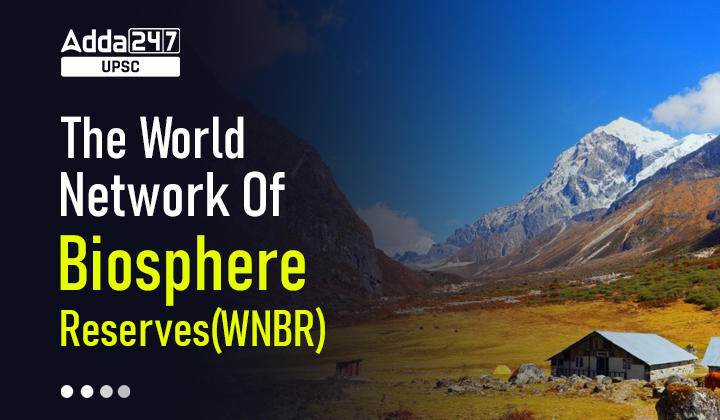Table of Contents
The World Network Of Biosphere Reserves(WNBR): About The World Network Of Biosphere Reserves(WNBR)
- The World Network of Biosphere Reserves (WNBR) was formed in 1971, as a backbone for biodiversity conservation, ecosystem restoration, and living in harmony with nature.
- There are now 738 properties in 134 countries, including 12 in India, four in Sri Lanka, and three in the Maldives.
The World Network Of Biosphere Reserves(WNBR): Why in news?
November 3 is the first ‘International Day for Biosphere Reserves’, to be celebrated beginning in 2022.
The World Network Of Biosphere Reserves(WNBR): What are Biosphere Reserves?
- Biosphere reserves are ‘learning places for sustainable development’.
- They are sites for testing interdisciplinary approaches to understanding and managing changes and interactions between social and ecological systems, including conflict prevention and management of biodiversity.
- They are places that provide local solutions to global challenges.
- Biosphere reserves include terrestrial, marine and coastal ecosystems. Each site promotes solutions reconciling the conservation of biodiversity with its sustainable use.
- Biosphere reserves are nominated by national governments and remain under the sovereign jurisdiction of the states where they are located. Biosphere
- Reserves are designated under the intergovernmental MAB Programme by the Director-General of UNESCO following the decisions of the MAB International Coordinating Council (MAB ICC).
- Their status is internationally recognized. Member States can submit sites through the designation process.
The World Network Of Biosphere Reserves(WNBR): Know about the World Network of Biosphere Reserves
- The World Network of Biosphere Reserves of the MAB Programme consists of a dynamic and interactive network of sites of excellence.
- It fosters the harmonious integration of people and nature for sustainable development through participatory dialogue; knowledge sharing; poverty reduction and human well-being improvements; respect for cultural values and society’s ability to cope with change – thus contributing to the 2030 Agenda and the Sustainable Development Goals (SDGs).
- Accordingly, the Network is one of the main international tools to develop and implement sustainable development approaches in a wide array of contexts.
- The World Network of Biosphere Reserves promotes North-South and South-South collaboration and represents a unique tool for international co-operation through sharing knowledge, exchanging experiences, building capacity and promoting best practices.
The World Network Of Biosphere Reserves(WNBR): Worldwide Distribution of Biosphere Reserves
- There are 738 biosphere reserves in 134 countries, including 22 transboundary sites.
- They are distributed as follows:
- 90 sites in 33 countries in Africa
- 36 sites in 14 countries in the Arab States
- 172 sites in 24 countries in Asia and the Pacific
- 308 sites in 41 countries in Europe and North America
- 132 sites in 22 countries Latin America and the Caribbean.
The World Network Of Biosphere Reserves(WNBR): What is MAB Program?
- The MAB programme is an intergovernmental scientific programme that aims to establish a scientific basis for enhancing the relationship between people and their environments.
- It combines the natural and social sciences with a view to improving human livelihoods and safeguarding natural and managed ecosystems, thus promoting innovative approaches to economic development that are socially and culturally appropriate and environmentally sustainable.
The World Network Of Biosphere Reserves(WNBR): Opportunities in South Asia
- South Asia offers countless options.
- In South Asia, over 30 biosphere reserves have been established. The first one was the Hurulu Biosphere Reserve, in Sri Lanka, with 25,500 hectares of tropical dry evergreen forest.
- In India, the first biosphere reserve was designated by UNESCO in 2000, namely, the blue mountains of the Nilgiris stretching over Tamil Nadu, Karnataka and Kerala.
- India’s network of reserves has gone from strength to strength.
- The existence of the new World Network of Mountain Biosphere Reserves provides a welcome opportunity for Bhutan and Nepal to establish their first biosphere reserves and participate in the world network.
- If these pockets of hope can expand, with at least one biosphere reserve per country in Bangladesh, Bhutan and Nepal until 2025 (with additional biosphere reserves in India’s North-East and along the coasts).
The World Network Of Biosphere Reserves(WNBR): Way Forward
- India is a vast sub-continent, an emerging superpower of unlimited opportunities. It has become an important global player on environmental sustainability issues. India is likely to become the world’s most populated country in 2023.
- Considering the massive long-term threats to human survivability (besides pandemics and armed conflicts), such as biodiversity loss, climate change, pollution and population dynamics, accelerated by the blind belief in technological solutions for all problems, we need many more biosphere reserves globally.
- It will give realisation to millions of people that a better future is truly possible — one where we will truly live in harmony with nature.



 TSPSC Group 1 Question Paper 2024, Downl...
TSPSC Group 1 Question Paper 2024, Downl...
 TSPSC Group 1 Answer key 2024 Out, Downl...
TSPSC Group 1 Answer key 2024 Out, Downl...
 UPSC Prelims 2024 Question Paper, Downlo...
UPSC Prelims 2024 Question Paper, Downlo...




